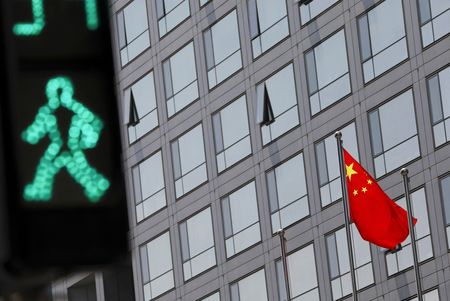
By Samuel Shen and Brenda Goh
SHANGHAI (Reuters) – China has raised the bar for issuances in the world’s second-biggest green bond market, taking a major step towards adopting global standards and eliminating ‘greenwashing’.
Starting this month, the Shanghai Stock Exchange, China’s premier bourse, requires 100% of the proceeds from green bond issuances to be invested in green projects such as clean energy – compared with at least 70% previously – according to a notice seen by Reuters.
Separately, the China Securities Regulatory Commission (CSRC) has instructed both the Shanghai and Shenzhen bourses to revise rules to bring issuances of such bonds in line with the newly published China Green Bond Principles, said two sources.
China published the Principles – a set of self-disciplinary green bond frameworks largely based on international standards – on July 29. The planned rule changes would make the guidelines mandatory for exchange-traded bonds, and reduce the risk of ‘greenwashing’, or exaggerated environment-friendly claims.
Sean Kidney, CEO of Climate Bonds Initiative (CBI), a London-based non-profit body that promotes investment in the low-carbon economy, said the changes would make China a leader in global green bond regulation.
Many securities regulators set voluntary green bond guidelines, “but to the best of my knowledge, China would be the first to make it mandatory”, he said.
It also means a lot more green bonds in China will become internationally recognised, potentially enabling China to overtake the United States as the world’s largest green bond market, he added.
China had issued roughly $200 billion of green bonds by the end of 2021, compared with slightly over $300 billion by the United States, according to CBI.
The bourses and the CSRC did not respond to requests for comment.
TWIN GOALS
China has stepped up efforts to develop green finance, seeking to channel low-cost funding into areas including renewable energy and electric vehicles so as to achieve President Xi Jinping’s twin goals of peak emission by 2030, and carbon neutrality by 2060.
Although a record $109.5 billion of Chinese green bonds were issued in 2021 – making China the fastest-growing major market for such bonds – nearly 40% of the issuance was not aligned with global definitions, according to CBI, which sets international standards.
The glitch was that in China’s fragmented bond market various regulators define green bonds differently, Kidney said.
Although green bond issuers in China’s interbank bond market already use 100% of proceeds on green projects, the CSRC, which regulates exchange-traded corporate bonds, only sets a green “use of proceeds” threshold of 70%, while the National Development & Reform Commission (NDRC), the watchdog of state-owned enterprise bonds, requires a minimum of 50%.
To promote rule harmonisation both at home and abroad, China published its own Green Bond Principles late last month, which are largely in line with principles issued by the International Capital Market Association (ICMA). China’s guidelines made it clear green bonds must use 100% of proceeds on green projects, in a nod to global practices.
In the notice sent to market participants, the Shanghai Stock Exchange, home to more than 300 billion yuan ($43.72 billion) worth of green bonds, asked underwriters to ensure future issuance complies with the principles.
In addition, the exchanges in both Shanghai and Shenzhen – a smaller corporate bond market – have been told by the CSRC to update relevant rules based on the principles, according to the sources.
($1 = 6.8616 Chinese yuan renminbi)
(Reporting by Samuel Shen and Brenda Goh; Additional reporting by Simon Jessop in London; Editing by Muralikumar Anantharaman)

